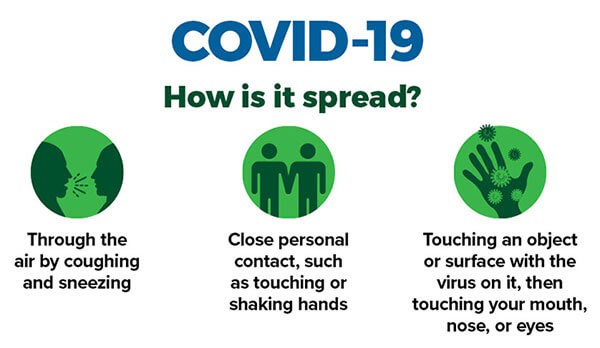Can COVID-19 Spread Through Drinking Water?

We all know how the global pandemic by COVID 19 has plagued the world. Originating out of Wuhan, China, the virus was first identified in December 2019, and with the spread of the so-called virus, the ongoing pandemic began.
The common symptoms associated with the virus are cough, fever, shortness of breath, fatigue, and loss of taste and smell.
Most of the cases only register mild symptoms. At the same time, some of them grow to ARDS or Acute Respiratory Distress Syndrome resulting in serious conditions like multi-organ failure, septic shock, blood clots, and even cytokine storm.
The usual time of the incoming of the symptoms after the exposure is usually five days, but it can also range over 14 days.
How is Covid-19 Transmitted?
COVID-19 spreads when individuals are in close contact, and one individual breathes in little droplets spread by a contaminated individual (indicative or not) sniffling, coughing, talking, or singing.
The WHO suggests 3 ft. or 1 meter of social distance. Individuals can transmit the infection without indicating side effects; however, it is hazy how frequently this occurs. One estimate of the quantity of those contaminated who are asymptomatic is 40%.

Individuals are most infectious when they show manifestations (even gentle or vague side effects); however, they might be infectious for as long as two days before indications show up. They stay infectious an expected seven to twelve days in the mild and normal cases and about fourteen days in extreme cases.
The study suggests that Coronavirus may spread through the air and contaminated objects. The chances of getting infected increase when you come in contact with an infected surface and then touch your nose, eyes, or mouth with your unwashed hands.
It is still not clear what amount of infection on surfaces is necessary to spread the Covid-19 infection.
Scientists discovered the virus is detectable for as long as 4 hours on copper, as long as one day on cardboard, and as long as three days on plastic and stainless steel.
“This virus is quite transmissible through relatively casual contact, making this pathogen very hard to contain,” said James Lloyd-Smith, a co-author of the study published in the New England Journal of Medicine, and a UCLA professor of ecology and evolutionary biology.
How to Protect Yourself from Covid-19?
The world has still not found any cure for this deadly virus and the only way to protect yourself from getting infected is to follow some easy tips:

- Wash your hands regularly. Use soap and water, or an alcohol-based hand sanitizer.
- Maintain at least 1 meter (3 feet) distance from any individual who is sneezing or coughing.
- Avoid touching your nose, eyes, and mouth.
- Cover your mouth and nose with your bowed elbow or a tissue when you cough or sneeze. Dispose of the tissue.
- Stay home if you feel unwell.
- If you have a fever, cough, and trouble breathing, seek medical advice promptly.
- Stay informed on the latest developments and follow the guidelines of your national and local public health authorities.
- Avoiding unnecessary visits to crowded places. Cover your mouth and nose with a mask or face cover when you step out of your home.
Can I Get Covid-19 Through Drinking Water?
Although presence, of the virus that causes COVID-19 infection, in drinking-water is possible, there is no evidence of its presence in surface or groundwater.
There is no evidence of Coronaviruses being transmitted through contaminated drinking water. Based on the current studies, the risk of drinking water contamination is very low.
Can Viruses Spread Through Drinking Water?
As per a 2012 estimate, 1.8 billion people (that is close to 25% of the world population) are consuming fecally-contaminated water. Fecally-contaminated water means water that contains bacteria, viruses, and protozoa. This water is the primary cause of the waterborne diseases in humans, the most common being gastroenteritis.
Almost 90% of worldwide deaths related to diarrhea are primarily caused by unsafe water, poor hygiene, and inadequate sanitation. And the worst affected our children under the age of five. In the year 2012, diarrhea resulted in over 1.2 million deaths of children in this age group.
As per the estimates of the World Bank, contaminated water and poor sanitation result in a global economic loss of US$260 billion annually.
The loss of human lives and the impact on the world economy, due to contaminated water, is staggering. That’s why providing access to safe drinking water is one of the biggest priorities of organizations like the World Health Organization (WHO) and the United Nations (UN).
Whenever we talk about biological contamination of water, the first thing that comes to our mind is the bacterial contamination. But what is lesser known is the contamination of viruses in drinking water and its impact on human health.

According to the World Health Organization, water-transmitted viruses, that pose moderate to severe health risk, include adenovirus, hepatitis A and E viruses, astrovirus, norovirus, rotavirus, and other caliciviruses, and enteroviruses, including coxsackieviruses and polioviruses.
Some of the viruses, like polyomaviruses and cytomegalovirus, which are excreted through urine, can also spread through water.
Some reports also suggest that other viruses, like influenza and coronaviruses, can also be transmitted through drinking water, but there is not enough evidence that can make it conclusive.
How to Detect Viruses in Drinking Water?
Water supplying agencies like the Municipal Corporations routinely check the water for the presence of all forms of contamination that includes biological contamination.
But most often this check does not cover the presence of infectious viruses because it is either unfeasible or not possible to detect infectious virus particles in a cost-efficient and timely manner.
While bacteria in water can be detected quite easily as compared to viruses, there are several technological barriers that prevent viruses in drinking water from being detected. This is because virus detection requires the use of complex and expensive technology like tissue culture.
Although there has been a lot of technological progress in this field, there is still no quick or easy way to detect viruses in large volumes of water.
How to Remove Viruses from Drinking Water?
Conventional, large-scale water treatment methods that use filtration and disinfection are very effective in inactivating the COVID-19 virus.
In the past, chlorination and disinfection with ultraviolet (UV) light have proven to be quite effective against other human coronaviruses. Enveloped viruses, like the COVID-19, are surrounded by a not so robust lipid host cell membrane. This makes COVID-19 more sensitive to chlorine and other oxidant disinfection processes than many other viruses that have a protein coat.

If your home does not have access to centralized water treatment and safe piped water supply then you can also use home water purification technologies like boiling or RO+UV water purifiers.
Endnote
Even though Covid-19 has spread throughout the world, creating the modern pandemic, one relief is that it is not spreading through drinking water. Moreover, the disinfection and purification methods used for drinking water provide the required safety against the spread of the coronavirus.



